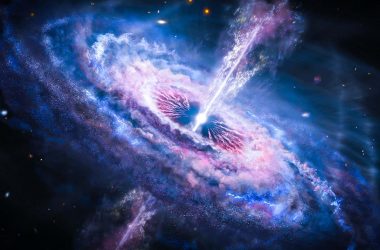Young star V960 Mon is surrounded by giant yellow spiral arms of dusty material in this image created by data from the SPHERE instrument, while the ALMA telescope reveals clumps (coloured blue) that could contract and collapse to form giant planets
ESO/ALMA (ESO/NAOJ/NRAO)/Weber et al.
In this captivating image, we can see a young star named V960 Mon that is being enveloped by massive arms of cosmic dust. These arms may eventually collapse and give rise to gas giant planets as colossal as Jupiter.
There are two main processes through which planets are believed to develop: core accretion and gravitational instability. In the core accretion process, solid particles orbiting a star collide and gradually accumulate to form a planet.
However, with gravitational instability, gas and dust come together to form clumps that collapse under their own gravity, eventually leading to the formation of gas giants. This process is thought to occur farther away from the host star compared to core accretion, where the temperatures are much cooler.
Up until now, there has been a lack of observational evidence to firmly establish the occurrence of planet formation through gravitational instability.
However, Philipp Weber and his team at the University of Santiago, Chile, have used the Spectro-Polarimetric High-contrast Exoplanet Research (SPHERE) instrument at the European Southern Observatory’s Very Large Telescope in Chile to detect the planet-forming process in action, resulting in the image shown above.
“No one had ever seen a real observation of gravitational instability happening at planetary scales – until now,” said Weber in a statement.
V960 Mon is located approximately 5000 light years away from Earth in the constellation Monoceros, which is named after the Greek word for unicorn. The star is incredibly energetic and is emitting powerful jets of gas, resulting in the formation of enormous spiral arms that extend further than the distance across our entire solar system.
Weber and his team also analyzed previous observations of V960 Mon made using another telescope, the Atacama Large Millimeter/submillimeter Array in Chile. They discovered that the spiral arms were undergoing fragmentation, which refers to the creation of clumps of gas and dust. This fragmentation process is believed to precede the formation of planets through gravitational instability.
Topics:












